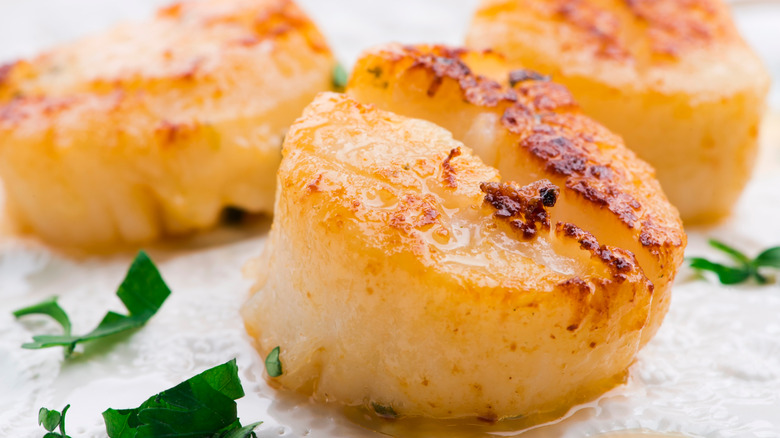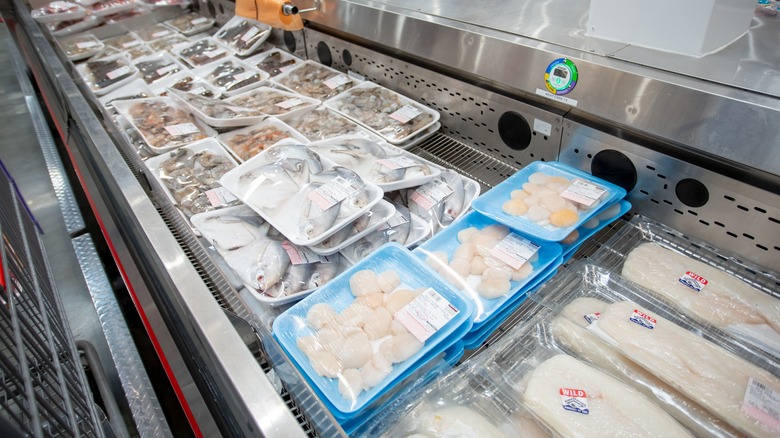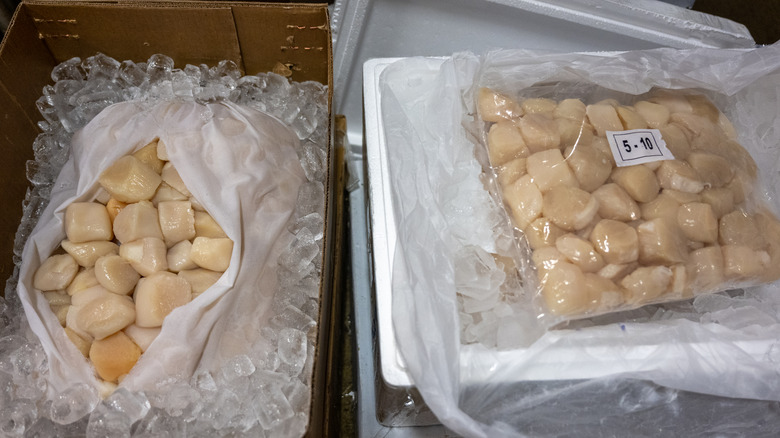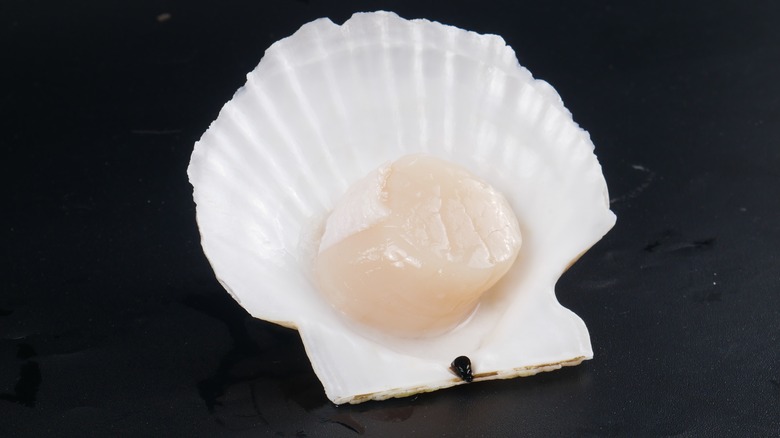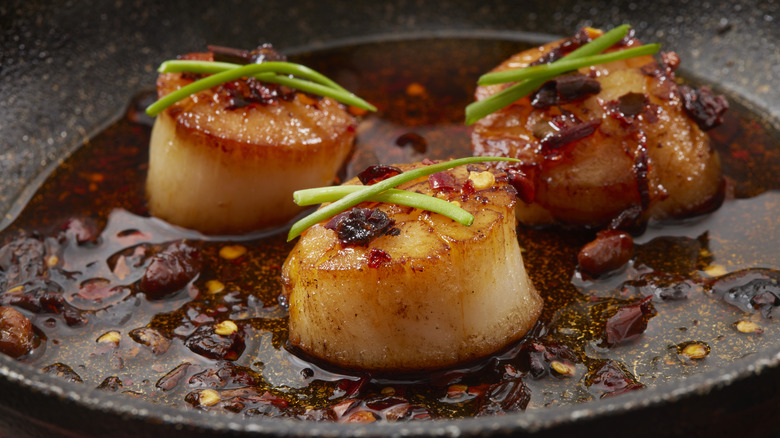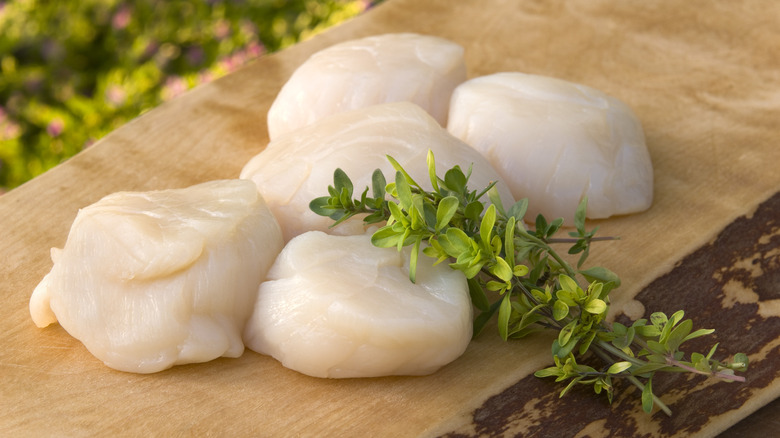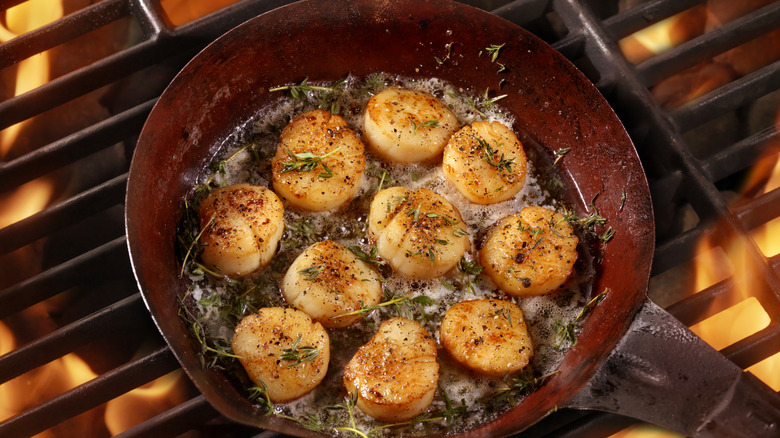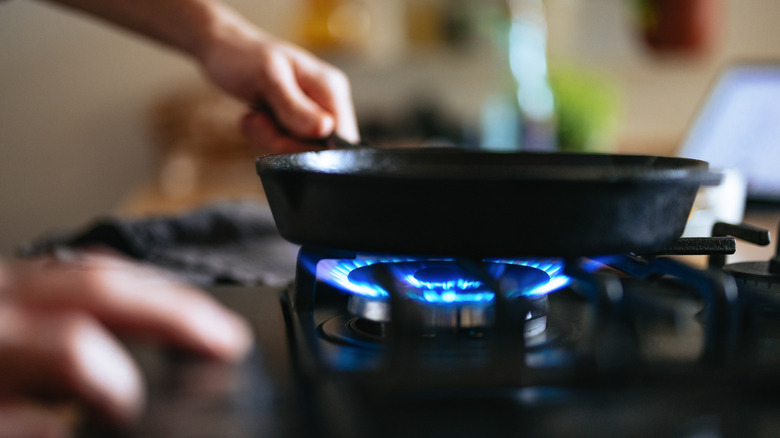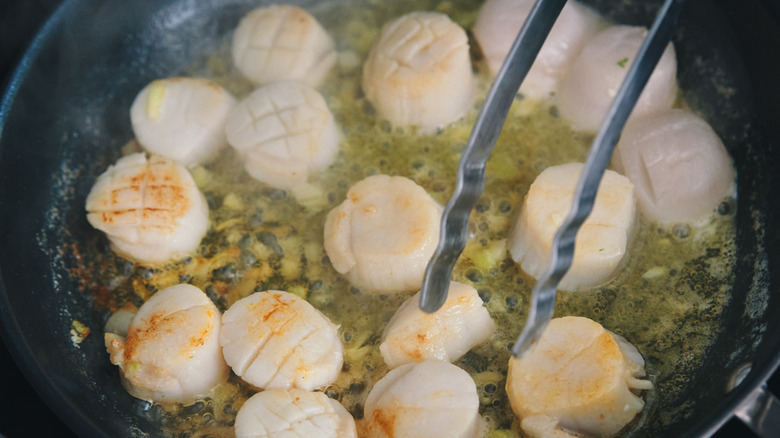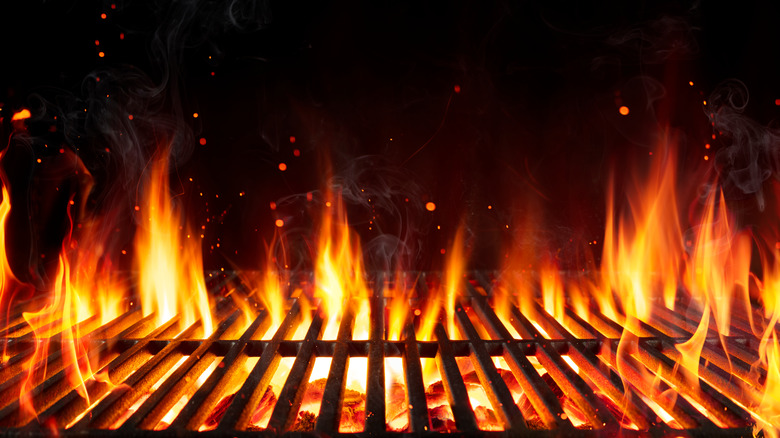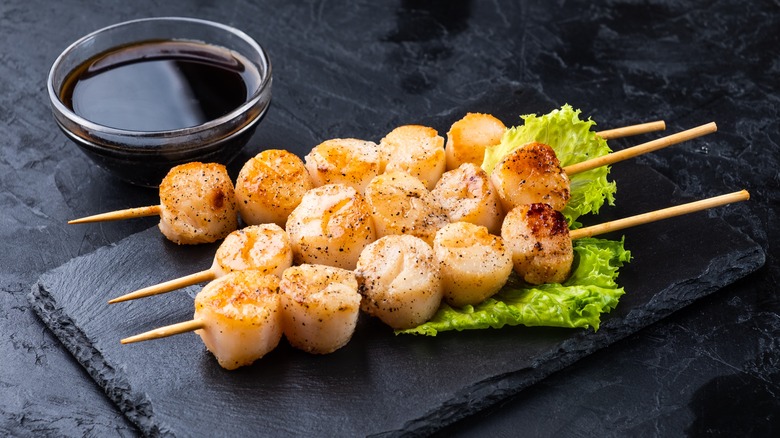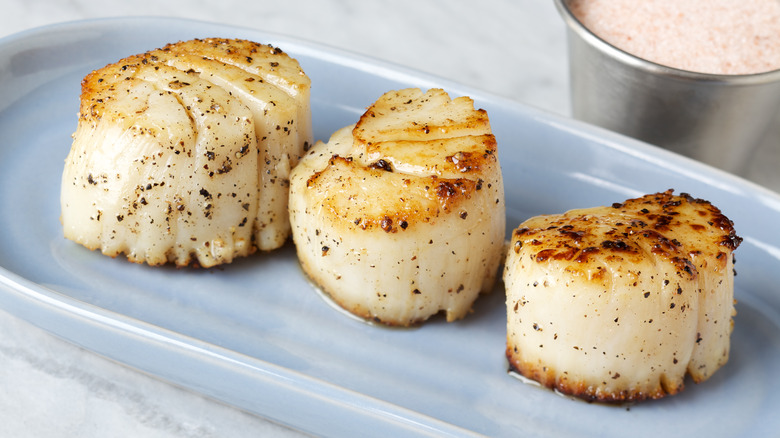Mistakes Everyone Makes When Cooking Scallops, According To Seafood Experts
Scallops are delicate and delicious little morsels of meat that many people may feel intimidated to cook in their own kitchens. They're a popular and nutritious seafood, but most people don't know how to cook them correctly. With proper instruction, scallops are surprisingly easy to prepare and one of the fastest-cooking protein sources available.
Thankfully, Foodie spoke with two seafood experts — chefs who regularly cook scallops in their New York City restaurants — about the best way to make scallops at home and the mistakes most people make. Our first expert, Chef Todd Mitgang, co-owns Crave Fishbar and the newly opened Crave Sushi Bar. Our second expert is the executive chef at Take Care, Chef Chris D'Ambrosio.
The two chefs detail 11 common mistakes people make when preparing or making scallops. Read these tips before cracking open a bottle of wine to pair with seafood, and they will become a shining star in any meal.
Buying wet scallops
You can find both wet and dry scallops at the grocery store, but dry scallops cook much better than their wet counterpart. The difference between the two relates to how they are harvested from the ocean and preserved later on land.
"Wet and dry scallops look very similar but differ in price," says Chef Todd Mitgang, "folks who buy wet scallops risk a watery and rubbery texture with many preservatives." That's because wet scallops retain more moisture and can be hard to sear to a nice golden brown. Wet scallops look more appealing at stores because of their artificial sheen and plumpness. Don't let appearances fool you — the excess mass and color come from preservatives that improve the scallops' look but detract from the texture and taste.
When preparing scallops at home, it's worth spending the extra money to get dry scallops that will sear easily and beautifully. But even with these dry scallops, pat them dry before cooking to extract as much moisture as possible.
Not defrosting properly
Buying dry, never-frozen scallops is ideal, but these varieties are not always available in non-specialty grocery stores. It's okay to buy frozen if necessary. "High-quality frozen scallops can be just as good as fresh ones if handled properly," our expert Chef Chris D'Ambrosio reassures us.
There is a proper and improper way to defrost scallops –and it all depends on timing. "The cellular walls of frozen scallops are often destroyed," says Chef Todd Mitgang, "and it can be a huge mess trying to thaw them out." To avoid this mess, you'll need to be gentle with the thawing process by letting them defrost naturally.
Thaw them slowly — starting the night before cooking them — by placing them in the refrigerator. Defrosting scallops quickly by skipping refrigeration or running them under hot water affects the quality of their texture and taste. They can become soggy or waterlogged, making them difficult to cook correctly.
Leaving the side muscle in tact
Most dry scallops that have not gone through the preservative process will have a small side muscle that needs to be removed before cooking. It's usually evident where the muscle is, even to the untrained eye. Looking at the cylindrical sides of the scallop, there may be a small raised bump or spot that is noticeably a darker white than the rest of the meat. This is the side muscle, or the "foot" of the scallop that, while technically edible, is rather unpleasant.
"It is indeed a mistake not to remove the side muscle from scallops," says Chef Chris D'Ambrosio, "the side muscle can be tough and chewy, detracting from the desired texture of the scallop." It's a rubbery little white spot that turns a perfect bite into an unpleasant one.
To remove, pinch the tag between your fingers and tear off the side muscle from the rest of the fleshy body. Most will easily rip off without needing a knife. Other scallops will already have had their side muscle removed during the harvesting or preserving processes.
Using too much marinade
Less is more when it comes to seasoning or marinating your scallops. According to Chefs Todd Mitgang and Chris D'Ambrosio, most chefs prepare their scallops without a brine or marinade to let the "natural sweetness" shine. A quick sprinkle of salt and pepper on each side of the scallop should do the trick.
Choosing to marinade, though, isn't "necessarily a mistake," says Chef D'Ambrosio. Adding a marinade or dry seasoning will introduce more flavor to scallops and help prevent them from drying out while cooking. Some smoked paprika or coriander can go a long way. If you're choosing to marinate scallops with a sauce, make sure the faces are relatively dry to make a nice sear. Otherwise, the scallops may finish with a slightly chewy texture.
Instead of using a hearty marinade before cooking, try serving lightly seasoned scallops with a dipping sauce or drizzle after they are plated. Some chili oil, soy sauce, or honey work beautifully on top of a scallop and don't require cooking beforehand.
Not cooking the correct face first
While it's easy to miss to the untrained eye, there is a right and wrong side on which to first cook your scallop. The flatter, wider ends are called the scallop's "faces." When first placing scallops in the sauté pan, you want to make sure you are putting the face with the larger circumference on the bottom, making contact with the pan.
Chef Todd Mitgang explains why: "the contact side [of the scallop] will have a larger surface area, leading to more caramelization." That means the perfect sear you're looking for will be bigger, deeper, and more noticeable when you take that first bite.
The size difference between the two faces of the scallop probably won't be super noticeable at first, as both ends will be around the same circumference. But, looking a little further, you should be able to see which end is slightly bigger and should face down on the pan first. Cooking scallops on their sides or with the wrong side face-down could lead to a faulty structure and the scallops falling apart on your plate.
Overcrowding the pan
LIke most foods cooked on a stovetop or grill, you don't want to overcrowd the pan when searing your scallops. According to Chef Chris D'Ambrosio, this is another common mistake people make. So, just be sure to give them plenty of room so that none of the sides touch one another.
Scallops will shrink a little as they cook, so more room will have developed in your pan when they're done. Still, you don't want to have made it this far only to have unevenly cooked scallops because of overcrowding. If it's your first time cooking them at home, start off with a small batch of four to six in your pan. If those come out nicely seared, try making six to eight more, depending on the size of your pan.
Leaving the scallops touching in the pan causes them to steam instead of sear. Liquid gets trapped between two scallops — which will effectively cook them but not allow for that slightly crispy texture. Instead, leave about half an inch (or more) between each scallop to allow them to cook undisturbed.
Cooking at the incorrect temperature
Make sure that your sauté pan is hot enough before adding the scallops. "Scallops need to be cooked over medium to high fire in avocado oil and butter," explains Chef Todd Mitgang.
The medium-high heat allows your scallops to sear properly. Cooking on a heat that's too low will not give your scallops the impossibly golden brown crisp you need for seafood. Cooking them too hot will burn them or sear the bottom before giving the rest of the meat time to fully cook.
Butter and avocado oil work to coat the scallops so they don't stick to the pan, adding a subtle sweet, buttery flavor. If you don't have avocado oil, a different high smoke point oil will work just as well. Vegetable oil, peanut oil, or grapeseed oil will do the trick. Avoid olive oil, as its low smoke point will leave you with burnt scallops that are raw on the inside.
Flipping them over too early
Disturbing your scallops too early or too late will result in an unpleasant texture. "You'll want to cook them until you see a browning come up on the side before flipping," instructs Chef Todd Mitgang. It won't take long for that browning to occur — only about 3 minutes on the first side. Once you see the coloration on the sides of the scallops begin to change, you'll know they are fully seared across their larger bottom face.
You're almost done at this point. Once they have achieved a significant browning across the bottom edges, gently flip them over and let them cook for another minute or two. If the scallops stick to the pan, let them cook for a short while longer.
"By preheating the pan properly, patting the scallops dry, and allowing them to cook undisturbed," says Chef Chris D'Ambrosio, "I ensure they develop a deep caramel crust while remaining tender and succulent inside."
Cooking them for too long
Overcooking scallops is one of the most common mistakes people make. "Scallops are delicate and can easily become overcooked, resulting in a rubbery texture," says Chef Chris D'Ambrosio, adding, "overcooking typically occurs when they are left on the heat for too long, causing them to lose moisture and become tough."
There are many reasons why someone might overcook their scallops. Being overcautious is one of them. People tend to let their scallops cook for longer than necessary in fear of consuming raw or undercooked seafood. Others try to get that elusive sear by cooking on low heat for longer. Chef D'Ambrosio shares with us the one true way to sear scallops properly. "The key is to cook them quickly over high heat, just until they are opaque and firm to the touch."
Feeling your scallops after flipping is the best way to determine doneness. "You want to be there and understand what a medium scallop feels like," says Chef Todd Mitgang, "it should be firm, but not too firm."
Solely sticking to the sauté pan
Once you've got the hang of the basics, explore different methods for cooking scallops. Our experts recommend "grilling, baking, or even incorporating them into ceviche or sushi preparations."
"I like to pop them into the oven for 2 minutes at 350 degrees Fahrenheit," says Chef Todd Mitgang. The oven gets them nice and hot inside before transferring them to the stovetop to complete that perfect sear. "In addition to searing, I like to grill scallops on a griddle or grill over a high fire." One unique way to prepare scallops is skewered over the grill, similar to the Japanese chicken yakitori.
Chef Chris D'Ambrosio gets creative with his scallops as well. "There are other preparation techniques that people often neglect," he says, "another method I enjoy is broiling." Broiling scallops in your oven also takes almost no time at all. Preheat to a high broil and put the dry scallops in for 6 to 8 minutes. The open flame will give them a nice golden brown sear, but keep a watchful eye on them so they don't burn.
Serving them too late
Scallops are best served freshly seared out of the pan or off the grill. Allowing them to cool down to room temperature before you serve them will cause them to lose their soft, pillowy texture. Plus, the flavor of a scallop that has been sitting around just isn't as good as one fresh from the stovetop.
If you're making scallops in batches, put the oven on a low heat setting and store them there while making more. This will ensure the scallops stay hot without overcooking them.
If needed, cooked scallops can be refrigerated and served later after reheating. Warm them over low heat on the stovetop or at a low heat setting in your microwave for 20 seconds each. Reheated scallops won't necessarily be as good the second time around, but if seared properly while cooking, they should maintain a nice soft and pillowy texture.
